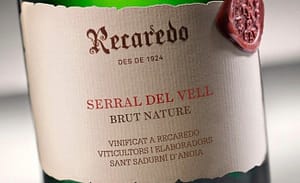Valtravieso was a new find on our journey over the Castilian meseta.
.
Located in Piñel de Arriba in the Valladolid province some 920-950 meters above sea level it is one of the highest in the DO Ribera del Duero (except for some parts in the eastern Soria province).
The treatments are natural, the land is worked carefully, the farming is dry, and nothing is done that doesn’t need to be done.
-Here is a long ripening processes, which is good for the aromas and flavours and improves the acidity in the wines, explains winemaker Ricardo Velasco. -The long sun exposure gives good colour to the grapes. There are great differences between day and night, especially in summer, when temperature can drop 18º C. This brings more polyphenols, and with it higher antioxidant content.

The soils are poor. Some parts are more calcareous, others have more clay, which also contributes to more polyphenols. In addition some grapes are bought in from Gumiel (over in the Burgos province) and from Soria. The estate now consists of 54 hectares, that count for half of the wine production, but there will be planted at least 20 more.
The farming is organic, not certified though. -But it’s very easy here, with healthy soils and with the wind sweeping through the vineyards, says Ricardo. They will soon make their own compost too.

Cabernet franc is preferred to CS, as it is easier to work because of its shorter growth cycle
Ricardo thinks that ideally a malolactic fermentation should be done in barrel, as it’s easier to integrate it. But Valtravieso is a new and relatively small winery, and he choses to be pragmatic, as it’s much easier to do one tank than -say- 44 barrels. But on the other hand, after the wine has stayed one year in barrel the result is practically the same.
Like many Ribera producers, a rueda wine is also made. Ricardo choses to do this in Miguel Arroyo’s bodega in the southern part of Valladolid. This we will come back to at a later occation.


The bodega building is air-conditioned at 16 and 18°C.
Ricardo told us about one special barrel, where he kept a favourite wine of his, that he calls “Listilla”. It’s a natural wine, nothing added nothing taken away. -I hope the boss will like it, he says. We tasted it, and we can promise a very pure, fruity, grapey wine, a high acidity tempranillo.

The Listilla barrel
At Valtravieso they believe in launching the wines on the market when they are approaching their peak for consumption. This is how it used to be all over the country, but in today’s market it’s rather unusual.
Among the wines we tasted were the Crianza 2015 and a tinta fina, also from 2015.
The Crianza is from 60% own grapes, the rest from Burgos and Soria. It’s a mix between tinta fina (tempranillo), cabernet (franc rather than sauvignon) and merlot, aged in French oak for a little more than a year.
Crianza 2015: Cherry red. Very fruity, some coffee, spice, herbs, pine. Rich, but with a fresh acidity, long, and the high alcohol (14,5%) is no problem.
The Tinta Fina is so called because it is from only tinta fina, and 100% from the estate. It’s a single vineyard, which here means from a single parcel of old vines, and with very low yields.
Tinta fina 2015: Dark. Very fruity, with blackberry, pine, truffles, and a flinty mineral character. A lot of structure, rich, somewhat heavy at 15% alcohol, but still the fine acidity shines through.

After a tour in the cellar, with samples, we had a wonderful tasting of some bottled wines in this room. Here is a view of a typical Castilian landscape, a high plain, seemingly not especially welcoming, but of the type that Dutch writer Cees Noteboom said “you have to conquer”. Here we eventually sat down, contemplated to a sip of the Gran Valtravieso.
The best grapes from more than 80 years old vines go into this wine. The fermentation is carried out at a controlled temperature, followed by 35 days of maceration. For this wine the malolactic fermentation takes place in French oak barrels. It used to be aged for three years in wood from three different French forests, but nowadays it stays 12-15 months in concrete.
Gran Valtravieso 2014:
Dark cherry red. Very fruity, cool aroma, with red berries, a balsamic note, hints of vanilla and toffee. It’s rich, yet luscious, with high acidity that contributes to the long aftertaste. I would call it elegant, but due to the alcohol content it’s advisable to cool it down a bit.
















